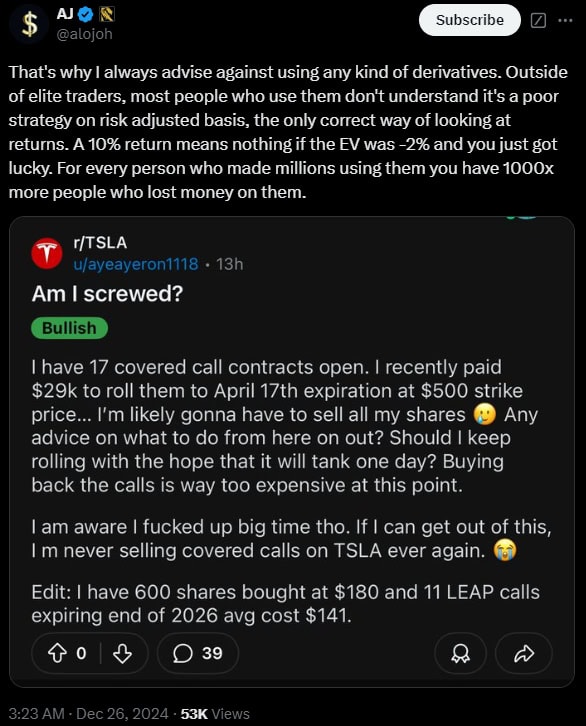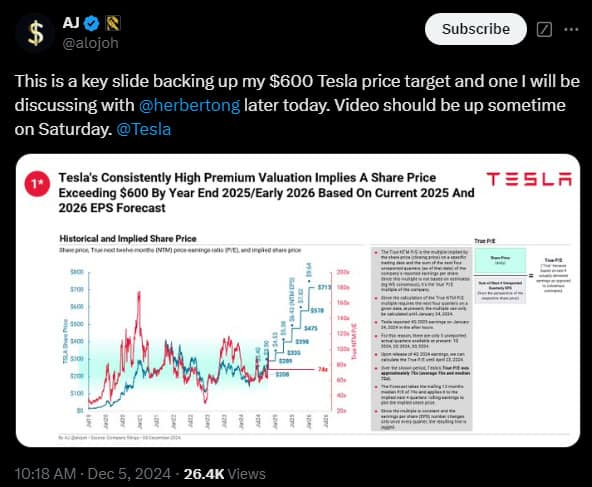Stock Volatility Secrets: How To Profit When Others Panic

“Volatility is the toll we pay to invest”—but what if you could COLLECT that toll instead of paying it?
Stock volatility creates real emotions of excitement and fear, often sparking polarizing debates, and no other than my favorite AI stock, TESLA, with its passionate investor base, fully displays market psychology.
How is stock volatility an asset? How do people ignore that?
The Catalyst: A Post That Caught My Attention
As an investor in Tesla myself, I follow AJ on X because he’s one of the top analysts to follow.
With that said, he had a post about selling covered calls on Tesla (which I do) that caught my attention:
I read all of the comments, and frankly most were uninformed and overly emotional.
It was clear that many people commenting didn’t fully understand the strategy or its purpose.
Selling covered calls isn’t gambling or “betting against the stock”; it’s a calculated way to generate income while managing risk in a volatile market like Tesla’s.
BUT, before I respond to these misconceptions, let’s stop and analyze this person’s position.
Now, we can only make some assumptions because there was some lack of detail, but based on what we know…
June 20, 2024 was the last time Tesla was under $180, so let’s use that date as the last time to acquire some shares. 600 shares for $180 = $108,000.
On December 18th, Tesla hit an all-time high of $488.54 which would make the position worth $293,124.
Great, but he also had LEAPS (Long-term Equity AnticiPation Securities), which are just longer dated option positions.
Ideally these should be bought with:
- Lower Volatility (to avoid paying too much premium), which for Tesla this year was lower in Mid-May, end of August, and Mid-October after the 10/10 event.
- Deeper in the money (I.T.M.), to avoid paying for extrinsic value (topic for another day)
But let’s say this person waited to the election euphoria and bought the $180 Dec.2026 calls on Nov.6th for $141 like it implied. 11 x $14100 ($141 for 1 call = 100 shares) = $155,100.
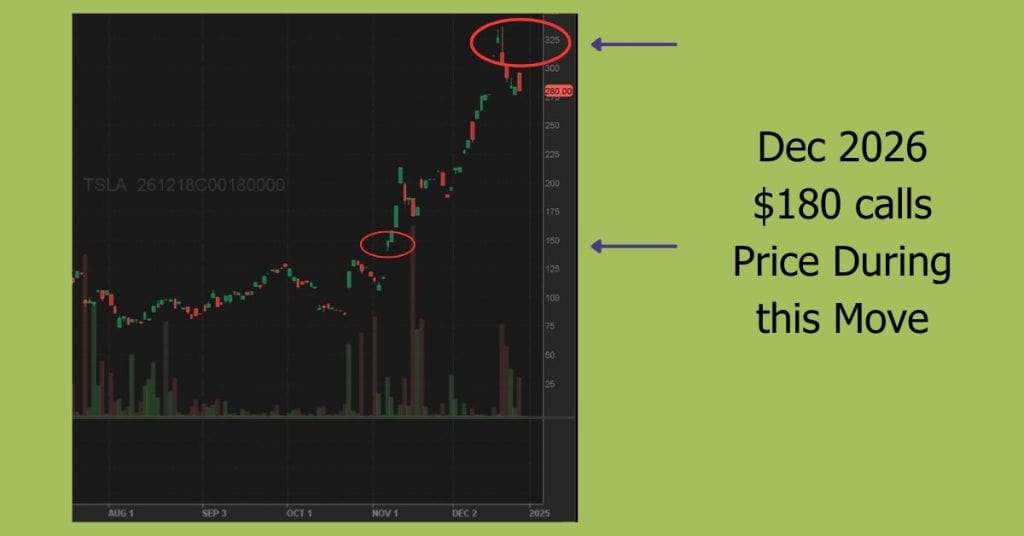
Which would have made them worth $369,820 ($336.20 x 100 x 11) on high of December 18th.
So, at the high the position was worth $662,944 with a gain of $400k. Up 152% in a few months.
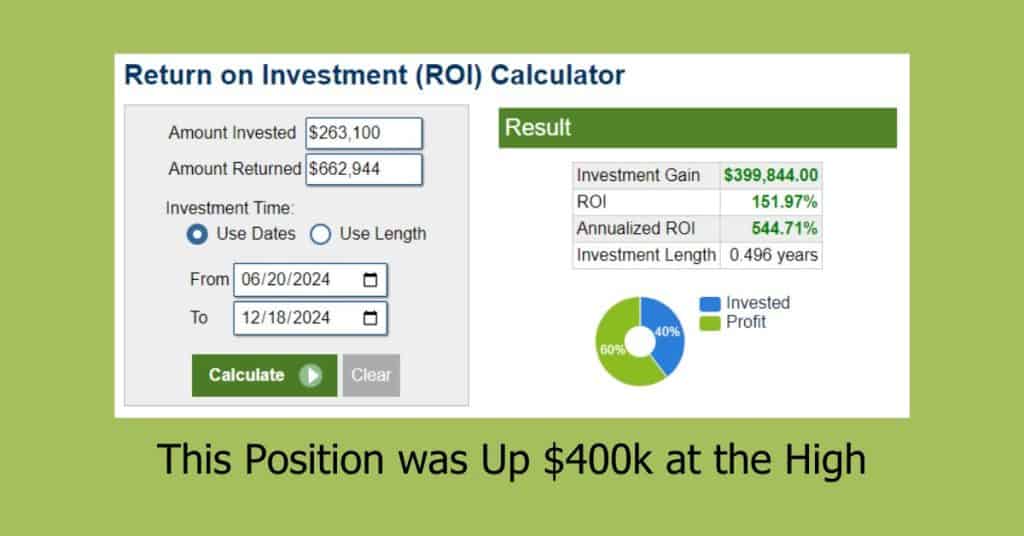
Not bad, right?
Of course this is looking at an unrealized profit at a peak, and that’s where the covered call strategy comes into play.
Breaking Down the Misconceptions
There were many misconceptions in the comments, so let’s address a few.
1. Stock Volatility
Most people fear VOLATILITY, because it is associated with risk and fear, but volatility is just price movement, and that’s an opportunity!
Who wants to own an asset that doesn’t move? Where’s the opportunity to make money if you have money sitting in a dead asset!
Now usually volatility spikes during prices falling, but in this situation with Tesla, STOCK UP VOL UP! The perfect situation for covered calls.
You are up in your long stock position, and now the implied volatility jacks up the premium so much that you can sell a far out of the money covered call and take advantage of the opportunity.
Since, we don’t know what strikes were used in the post, let’s see an example of what I’m talking about.
I’ve seen all sorts of Tesla price predictions, and AJ himself talked about Tesla being $600 a share by the end of 2025.
BUT the Jan. 2025 $600 strike was priced at an extreme.
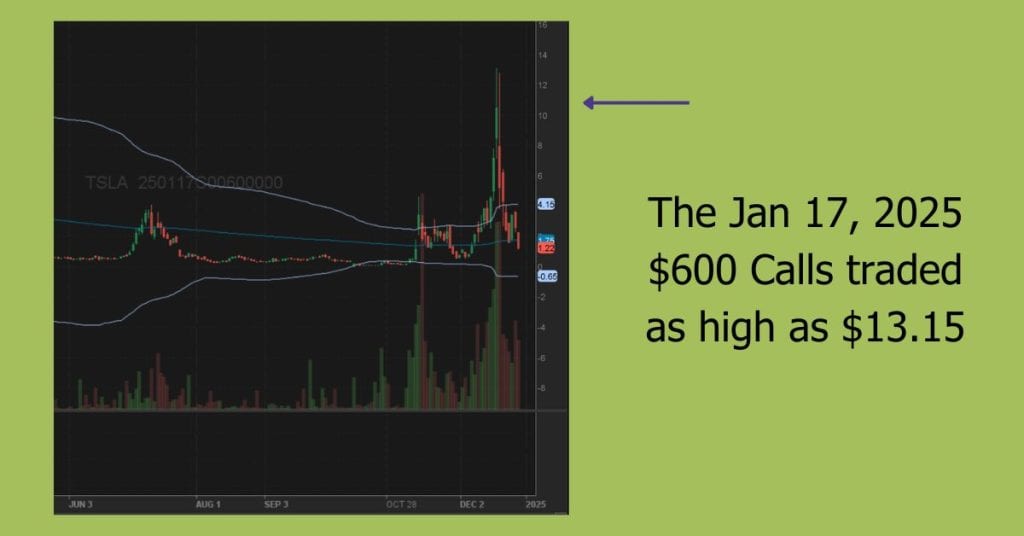
Ok, so you NOT going to pick the top, let’s say you sold them for $10, and collected $17,000 on that position for a month!
Now, that volatility and the stock has pulled back, you can take that off and still be holding your long position.
2. Selling Calls is Bearish
This statement was one of the most ill-informed comments, because it’s simply not true.
At worst it can be said that it’s neutral or less bullish, depending on strike selection, BUT certainly NOT BEARISH.
This is not someone selling naked calls or shorting the stock, this was someone carrying a long position (BULLISH), which equates to long deltas.
Long 600 shares, which means long 600 deltas, and best guess on the 11 deep ITM calls, close to another long 990 deltas.
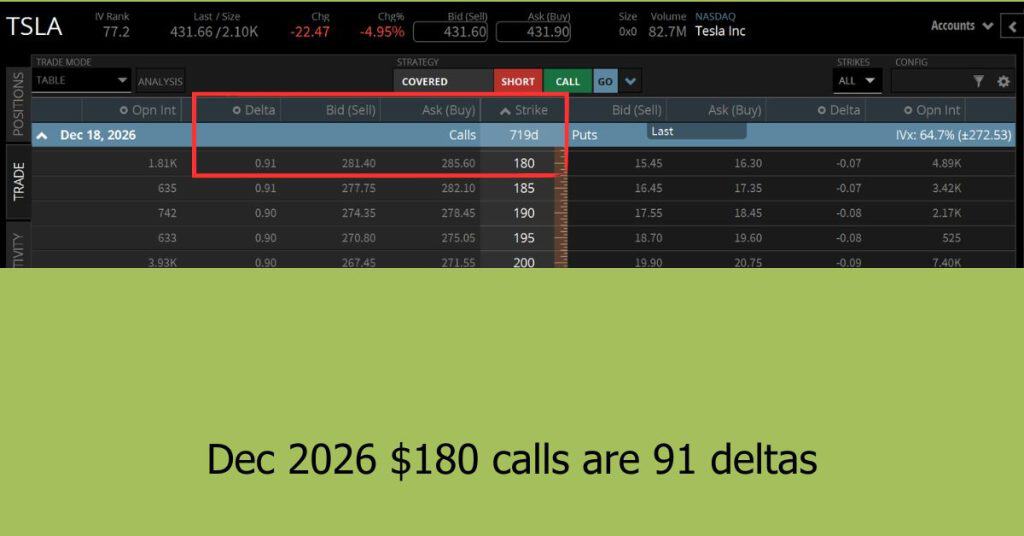
A conservative 20 delta covered call on the controlled 1700 shares, would reduce the long position 340 deltas on the whole position, making it a long position of 1250 deltas instead of 1590 deltas.
3. Options are Gambling
Let’s get something straight: Options trading can feel like gambling, but it doesn’t have to be.
Slinging options around in the vain of trying to “get rich”—I’ll admit, it can feel a little like rolling dice at a casino. The thrill, the jargon, the stories of people making or losing fortunes overnight—it’s no wonder options get labeled as gambling.
But here’s the truth: options trading is only gambling if you treat it like gambling.
You hear the stories…Buy a few out-of-the-money calls on a stock that “just knew” was going to skyrocket.
Spoiler alert: it normally doesn’t.
What is gambling?–risking your money with no plan or edge.
The key to trading options without falling into the gambling trap is to have a clear, repeatable strategy.
Selling covered calls on stocks I already own, for instance, is a great way to generate extra income.
It’s like collecting rent on a property you already own. Sure, you cap your upside if the stock shoots to the moon, but the trade-off is steady, reliable income. That doesn’t feel like gambling to me—it feels like smart investing.
Let’s break it down. When you sell a covered call, you’re saying, “I’ll agree to sell my stock at a certain price if it gets there, but I’ll collect a premium today no matter what happens.” The market can go up, down, or sideways, and you’re still walking away with the premium.
Compare that to buying a lottery ticket (or even an out-of-the-money call): most of the time, you’ll end up with nothing. Selling options gives you an edge. It puts the probabilities in your favor, which is the opposite of gambling.
Now, let’s look at the above example again.
This investor put $263,100 towards Tesla as an investment. If you use my example of collecting $17,000 on this position, they would have reduced the cost of this position by 6.5%, isn’t that a prudent and conservative way to invest?
Even the market dealers were hedged at the $500 strike for the next expiration cycle. There wasn’t much price action beyond that…

So, is options trading gambling? It can be, if you’re a reckless individual.
But with the right mindset, education, and strategies, it’s not only far from gambling—it’s one of the smartest tools you can use to navigate stock volatility.
That’s how you turn what feels like a gamble into a calculated, strategic way to build wealth.
How to Harness Stock Volatility
Stock volatility can feel like a rollercoaster—But here’s the thing: volatility isn’t something to fear.
Embrace it because it’s your opportunity. When you understand how to use it, it can become one of the most powerful tools in your investing toolkit.
1. UNDERSTAND IT
The first step in harnessing stock volatility is understanding it.
Volatility measures how much a stock’s price fluctuates over time. A stock like Tesla has high volatility—it can swing $20 or more in a single trading session.
On the other hand, a utility stock might barely budge.
Neither is good or bad; they just require different approaches.
2. USE IT
So, how do you use volatility to your advantage?
My go-to method is through options trading, like selling options.
Selling options works especially well in volatile markets because higher volatility means higher premiums.
When you sell a covered call on a stock you own, you’re getting paid for taking on some of that volatility. And when volatility spikes—like during earnings season—you can often collect even juicier premiums.
Another strategy I love is using cash-secured puts to buy stocks at a discount. Which is how I got into Tesla as a holding.
Let’s say Tesla’s trading at $250, but you’d love to own it at $200. You sell a put with a $200 strike price, collect a premium upfront, and if the stock drops, you’ll buy it at a lower price (plus keep the premium). If it doesn’t drop? You still keep the premium. Win-win.
Buying Tesla at a discount…Love it!
Pay attention to implied volatility (IV). This measures the market’s expectation of future price swings. When IV is high, options are more expensive, which benefits sellers. When IV is low, it might be a good time to buy options since they’re cheaper. I always check IV before placing a trade—it’s like checking the weather before heading out.
3. HAVE PERSPECTIVE
At the end of the day, harnessing stock volatility comes down to preparation and perspective.
Now, this investor may have made a mistake rolling out to April, because that really is too long for selling a covered call. BUT being called an idiot for taking this position because Tesla is “going to $1000 by April” is just as idiotic.
Understand what drives volatility. Use tools like options to manage risk and generate income. And most importantly, keep a level head when the market gets crazy.
Volatility isn’t your enemy—it’s the key to unlocking new opportunities. You just need to know how to ride the wave.
FAQs
Get answers to a list of the most Frequently Asked Questions.
Bottom Line
Volatility is often seen as the enemy of investors, but it doesn’t have to be.
With the right mindset, tools, and strategies—like selling covered calls or using puts to your advantage—you can turn stock volatility into a powerful ally.
Whether generating steady income, protecting your portfolio, or capitalizing on price swings, volatility creates opportunities for those prepared to embrace it.
Don’t fear it, navigate the opportunity.

